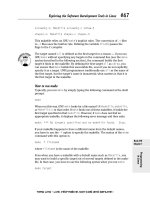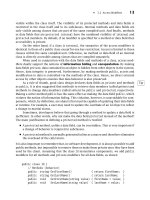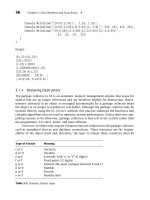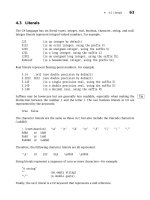TCP/IP Sockets in C# Practical Guide for Programmers phần 6 ppsx
Bạn đang xem bản rút gọn của tài liệu. Xem và tải ngay bản đầy đủ của tài liệu tại đây (100.72 KB, 19 trang )
■
3.5 Wrapping Up 83
RecvUdp.cs
0 using System; // For Int32, ArgumentException
1 using System.Net; // For IPEndPoint
2 using System.Net.Sockets; // For UdpClient
3
4 class RecvUdp {
5
6 static void Main(string[] args) {
7
8 if (args.Length != 1 && args.Length != 2) // Test for correct # of args
9 throw new ArgumentException("Parameter(s): <Port> [<encoding>]");
10
11 int port = Int32.Parse(args[0]); // Receiving Port
12
13 UdpClient client = new UdpClient(port); // UDP socket for receiving
14
15 byte[] packet = new byte[ItemQuoteTextConst.MAX_WIRE_LENGTH];
16 IPEndPoint remoteIPEndPoint = new IPEndPoint(IPAddress.Any, port);
17
18 packet = client.Receive(ref remoteIPEndPoint);
19
20 ItemQuoteDecoderText decoder = (args.Length == 2 ? // Which encoding
21 new ItemQuoteDecoderText(args[1]) :
22 new ItemQuoteDecoderText() );
23
24 ItemQuote quote = decoder.decode(packet);
25 Console.WriteLine(quote);
26
27 client.Close();
28 }
29 }
RecvUdp.cs
3.5 Wrapping Up
We have seen how C# data types can be encoded in different ways and how messages
can be constructed from various types of information. You may be aware that the
.NET framework includes serialization capabilities: The System.Xml.Serializable and
84 Chapter 3: Sending and Receiving Messages
■
System.Runtime.Serialization.Formatters name spaces contain classes that support
writing a C# class instance to an XML (eXtensible Markup Language) file, binary format,
or SOAP (Simple Object Access Protocol) message suitable for sending over a network
connection. Once at the remote host, the file can be deserialized into a instance of that
object. Similarly, the System.Runtime.Remoting name space allows the ability to create a
remote proxy object that a client can use to invoke methods on a server’s object. It might
seem that having these interfaces available would eliminate the need for what we have
described in this chapter, and that is true to some extent. However, it is not always the
case for several reasons.
First, the encoded forms produced by Serializable may not be very efficient. They
may include information that is meaningless outside the context of the Common Language
Runtime (CLR), and may also incur overhead to provide flexibility that may not be needed.
Second, Serializable and Remoting cannot be used when a different wire format has
already been specified—for example, by a standardized protocol. And finally, custom-
designed classes have to provide their own implementations of the serialization interfaces
anyway.
A basic tenet of good protocol design is that the protocol should constrain the imple-
mentor as little as possible and should minimize assumptions about the platform on
which the protocol will be implemented. We therefore avoid the use of Serializable and
Remoting in this book, and instead use more direct encoding and decoding methods.
3.6 Exercises
1. What happens if the Encoder uses a different encoding than the Decoder?
2. Rewrite the binary encoder so that the Item Description is terminated by “\r\n”
instead of being length encoded. Use Send/RecvTcp to test this new encoding.
3. The nextToken() method of Framer assumes that either the delimiter or an end-of-
stream (EoS) terminates a token; however, finding the EoS may be an error in some
protocols. Rewrite nextToken() to include a second Boolean parameter. If the param-
eter value is true, then the EoS terminates a token without error; otherwise, the EoS
generates an error.
4. Using the code provided on the website of the Java version of this book ([25],
www.mkp.com/practical/javasockets), run a C# receiver and a Java sender, and
vice versa. Verify that the contents are sent and received properly. Try removing
the NetworkToHostOrdering() and HostToNetworkOrdering() method calls and
rerunning the experiment.
chapter 4
Beyond the Basics
The client and server examples in Chapter 2 demonstrate the basic model for
programming with sockets in C#. The next step is to apply these concepts in vari-
ous programming models, such as nonblocking I/O, threading, asynchronous I/O, and
multicasting.
4.1 Nonblocking I/O
Socket I/O calls may block for several reasons. Data input methods Read(), Receive(),
and ReceiveFrom() block if data is not available. Data output methods Write(), Send(),
or SendTo() may block if there is not sufficient space to buffer the transmitted data.
The Accept(), AcceptSocket(), and AcceptTcpClient() methods of the Socket and
TcpListener classes all block until a connection has been established (see Section 5.4).
Meanwhile, long round-trip times, high error rate connections, and slow (or deceased)
servers may cause connection establishment to take a long time. In all of these cases, the
method returns only after the request has been satisfied. Of course, a blocking method call
halts the execution of the application. And we have not even considered the possibility
of a buggy or malicious application on the other end of the connection!
What about a program that has other tasks to perform while waiting for call comple-
tion (e.g., updating the “busy” cursor or responding to user requests)? These programs
may have no time to wait on a blocked method call. Or what about lost UDP datagrams?
Fortunately, several mechanisms are available for avoiding unwanted blocking behaviors.
We deal with three here: (1) I/O status prechecking, (2) blocking timeout calls, and (3) non-
blocking sockets. Table 4.1 summarizes the techniques according to the type of socket you
are using. Later, we’ll look at a fourth method, called asynchronous I/O, where instead
85
86 Chapter 4: Beyond the Basics
■
I/O Operation Socket Type Blocking Avoidance Options
Accepting a Socket 1. Set the socket to nonblocking before calling
new connection Accept().
2. Call Poll() or Select() on the socket before calling
Accept().
TcpListener 1. Only call AcceptSocket() or AcceptTcpClient() if
Pending() returns true.
Making a Socket 1. Set the socket to nonblocking before calling
new connection Connect().
2. Call Poll() or Select() on the socket before calling
Connect().
Send Socket 1. Set the socket to nonblocking before calling Send() or
SendTo().
2. Call Poll() or Select() on the socket before calling
Send() or SendTo().
3. Set the SendTimeout socket option before calling Send()
or SendTo().
TcpClient 1. Set the SendTimeout property before calling Write() on
the network stream.
Receive Socket 1. Set the socket to nonblocking before calling Receive()
or ReceiveFrom().
2. Call Poll() or Select() on the socket before calling
Receive() or ReceiveFrom().
3. Set the ReceiveTimeout socket option before calling
Receive() or ReceiveFrom().
4. Only call Receive() or ReceiveFrom() if property
Available > 0.
TcpClient 1. Set the ReceiveTimeout property before calling Read()
on the network stream.
2. Only call Read() on the TcpClient’s network stream if
the DataAvailable property is true. (The Length
property is not supported for NetworkStream.)
Table 4.1: Blocking Avoidance Mechanisms
of blocking, an I/O call immediately returns and agrees to notify you later when it has
completed.
4.1.1 I/O Status Prechecking
One way to avoid blocking behavior is not to make calls that will block. How is this
achieved? For some of the I/O calls that can block, we can precheck the I/O status to
■
4.1 Nonblocking I/O 87
see if I/O would block. If the precheck indicates that the call would not block, we can pro-
ceed with the call knowing that the operation will complete immediately. If the precheck
indicates that the call would block, then other processing can be done and another check
can be done later.
When reading data with a TcpClient this can be achieved by checking the DataAvail-
able property of the associated NetworkStream, which returns true if there is data to be
read and false if there is not.
TcpClient client = new TcpClient(server, port);
NetworkStream netstream = client.GetStream();
:
:
:
if (netstream.DataAvailable) {
int len = netstream.Read(buf, 0, buf.Length);
} else {
// No data available, do other processing
}
A TcpListener can precheck if there are any connections pending before calling
AcceptTcpClient() or AcceptSocket() using the Pending() method. Pending() returns
true if there are connections pending, false if there are not.
TcpListener listener = new TcpListener(ipaddr, port);
listener.Start();
:
:
:
if (listener.Pending()) {
// Connections are pending, process them
TcpClient client = listener.AcceptTcpClient();
:
:
:
} else {
Console.WriteLine("No connections pending at this time.");
}
With the Socket class the availability of data to read can be prechecked using the
Available property, which is of type int. Available always contains the number of bytes
received from the network but not yet read; thus, if Available is greater than zero, a read
operation will not block.
Socket sock = new Socket(AddressFamily.InterNetwork, SocketType.Stream,
ProtocolType.Tcp);
sock.Connect(serverEndPoint);
:
:
:
if (sock.Available > 0) {
// We have data to read
sock.Receive(buf, buf.Length, 0);
:
:
:
88 Chapter 4: Beyond the Basics
■
} else {
Console.WriteLine("No data available to read at this time.");
}
The Poll() method of the Socket class also allows prechecking, among other
features, and is discussed in the next section.
4.1.2 Blocking Calls with Timeout
In the previous section we demonstrated how to check if a call would block prior to exe-
cuting it. Sometimes, however, we may actually need to know that some I/O event has not
happened for a certain time period. For example, in Chapter 2 we saw UdpEchoClientTime-
outSocket.cs, where the client sends a datagram to the server and then waits to receive a
response. If a datagram is not received before the timer expires, ReceiveFrom() unblocks
to allow the client to handle the datagram loss. Utilizing socket options, the Socket class
supports setting a bound on the maximum time (in milliseconds) to block on sending or
receiving data, using the SocketOption.SendTimeout and SocketOption.ReceiveTimeout
properties.
Socket sock = new Socket(AddressFamily.InterNetwork, SocketType.Stream,
ProtocolType.Tcp);
:
:
:
sock.SetSocketOption(SocketOptionLevel.Socket,
SocketOptionName.SendTimeout,
3000); // Set a 3 second timeout on Send()/SendTo()
If you are using the TcpClient class, it contains the SendTimeout and ReceiveTimeout
properties which can be set or retrieved.
TcpClient client = new TcpClient(server, port);
:
:
:
client.ReceiveTimeout = 5000; // Set a 5 second timeout on Read()
In both cases if the specified time elapses before the method returns, a Socket-
Exception is thrown with the Socket’s ErrorCode property set to 10060 (connection timed
out).
The Poll() method of Socket offers more functionality. Poll() takes two options:
an integer number of microseconds (not milliseconds) to wait for a response, and a mode
that indicates what type of operation we are waiting for. The wait time can be negative,
indicating an indefinite wait time (basically, a block). The wait time can also be zero,
which allows Poll() to be used for prechecking. The mode is set to one of the SelectMode
enumeration values SelectRead, SelectWrite,orSelectError, depending on what we are
checking for. Poll() returns true if the socket has an operation pending for the requested
mode, or false if it does not.
■
4.1 Nonblocking I/O 89
// Block for 1 second waiting for data to read or incoming connections
if (sock.Poll(1000000, SelectMode.SelectRead)) {
// Socket has data to read or an incoming connection
} else {
// No data to read or incoming connections
}
In general, polling is considered very inefficient because it requires repeated calls
to check status. This is sometimes called “busy waiting,” because it involves continu-
ously looping back to check for events that probably happen infrequently (at least in
relation to the number of checks made). Some ways to avoid polling are discussed later
in this chapter, including using the Socket method Select(), which allows blocking
on multiple sockets at once (Section 4.2), threads (Section 4.3), and asynchronous I/O
(Section 4.4).
A Write() or Send() call blocks until the last byte written is copied into the TCP
implementation’s local buffer; if the available buffer space is smaller than the size of
the write, some data must be successfully transferred to the other end of the connection
before the call will return (see Section 5.1 for details). Thus, the amount of time that
a large data send may block is controlled by the receiving application. Therefore, any
protocol that sends a large enough amount of data over a socket instance can block for
an unlimited amount of time. (See Section 5.2 for further discussion on the consequences
of this.)
Establishing a Socket connection to a specified host and port will block until either
the connection is established, the connection is refused, or a system-imposed timeout
occurs. The system-imposed timeout is long (on the order of minutes), and C# does not
provide any means of shortening it.
Suppose we want to implement the echo server with a limit on the amount of time
taken to service each client. That is, we define a target,
TIMELIMIT, and implement the server
in such a way that after
TIMELIMIT milliseconds, the server instance is terminated.
One approach simply has the server instance keep track of the amount of the remain-
ing time, and use the send and receive timeout settings described above to ensure
that reads and writes do not block for longer than that time. TcpEchoServerTimeout.cs
implements this approach.
TcpEchoServerTimeout.cs
0 using System; // For Console, Int32, ArgumentException, Environment
1 using System.Net; // For IPAddress
2 using System.Net.Sockets; // For TcpListener, TcpClient
3
4 class TcpEchoServerTimeout {
5
6 private const int BUFSIZE = 32; // Size of receive buffer
90 Chapter 4: Beyond the Basics
■
7 private const int BACKLOG = 5; // Outstanding conn queue max size
8 private const int TIMELIMIT = 10000; // Default time limit (ms)
9
10 static void Main(string[] args) {
11
12 if (args.Length > 1) // Test for correct # of args
13 throw new ArgumentException("Parameters: [<Port>]");
14
15 int servPort = (args.Length == 1) ? Int32.Parse(args[0]): 7;
16
17 Socket server = null;
18
19 try {
20 // Create a socket to accept client connections
21 server = new Socket(AddressFamily.InterNetwork, SocketType.Stream,
22 ProtocolType.Tcp);
23
24 server.Bind(new IPEndPoint(IPAddress.Any, servPort));
25
26 server.Listen(BACKLOG);
27 } catch (SocketException se) {
28 Console.WriteLine(se.ErrorCode + ": " + se.Message);
29 Environment.Exit(se.ErrorCode);
30 }
31
32 byte[] rcvBuffer = new byte[BUFSIZE]; // Receive buffer
33 int bytesRcvd; // Received byte count
34 int totalBytesEchoed = 0; // Total bytes sent
35
36 for (;;) { // Run forever, accepting and servicing connections
37
38 Socket client = null;
39
40 try {
41
42 client = server.Accept(); // Get client connection
43
44 DateTime starttime = DateTime.Now;
45
46 // Set the ReceiveTimeout
47 client.SetSocketOption(SocketOptionLevel.Socket,
48 SocketOptionName.ReceiveTimeout,
49 TIMELIMIT);
■
4.1 Nonblocking I/O 91
50
51 Console.Write("Handling client at " + client.RemoteEndPoint+"-");
52
53 // Receive until client closes connection, indicated by 0 return value
54 totalBytesEchoed = 0;
55 while ((bytesRcvd = client.Receive(rcvBuffer, 0, rcvBuffer.Length,
56 SocketFlags.None)) > 0) {
57 client.Send(rcvBuffer, 0, bytesRcvd, SocketFlags.None);
58 totalBytesEchoed += bytesRcvd;
59
60 // Check elapsed time
61 TimeSpan elapsed = DateTime.Now - starttime;
62 if (TIMELIMIT - elapsed.TotalMilliseconds < 0) {
63 Console.WriteLine("Aborting client, timelimit " + TIMELIMIT +
64 "ms exceeded; echoed " + totalBytesEchoed + " bytes");
65 client.Close();
66 throw new SocketException(10060);
67 }
68
69 // Set the ReceiveTimeout
70 client.SetSocketOption(SocketOptionLevel.Socket,
71 SocketOptionName.ReceiveTimeout,
72 (int)(TIMELIMIT - elapsed.TotalMilliseconds));
73 }
74 Console.WriteLine("echoed {0} bytes.", totalBytesEchoed);
75
76 client.Close(); // Close the socket. We are done with this client!
77
78 } catch (SocketException se) {
79 if (se.ErrorCode == 10060) { // WSAETIMEDOUT: Connection timed out
80 Console.WriteLine("Aborting client, timelimit " + TIMELIMIT +
81 "ms exceeded; echoed " + totalBytesEchoed + " bytes");
82 } else {
83 Console.WriteLine(se.ErrorCode + ": " + se.Message);
84 }
85 client.Close();
86 }
87 }
88 }
89 }
TcpEchoServerTimeout.cs
92 Chapter 4: Beyond the Basics
■
1. Argument parsing and setup: lines 12–17
2. Create socket, call Bind() and Listen: lines 19–30
3. Main server loop: lines 36–87
■
Accept client connection: line 42
■
Record start time: line 44
■
Set initial timeout: lines 46–47
Set the initial Receive() timeout to the
TIMELIMIT since minimal time should not
have elapsed yet.
■
Receive loop: lines 55–73
Receive data and send echo reply. After each receive and send, update and check
the elapsed time and abort if necessary. To abort we throw the same exception
a timeout during the Receive() would throw, which is a SocketException with
ErrorCode 10060. If we have not exceeded our timeout after the data transfer, reset
the Receive() timeout based on our new elapsed time before we loop around to
receive more data.
■
Successful completion: lines 74–76
If we successfully echo all the bytes within the timelimit, output the echoed byte
length and close the client socket.
■
Exception handling: lines 78–86
If we hit a timeout limit, output the appropriate message. Close the client socket
and allow the receive loop to continue and handle more clients.
4.1.3 Nonblocking Sockets
One solution to the problem of undesirable blocking is to change the behavior of the socket
so that all calls are nonblocking. For such a socket, if a requested operation can be com-
pleted immediately the call’s return will succeed. If the requested operation cannot be
completed immediately, it throws a SocketException with the ErrorCode property set to
10035 with a Message of “Operation would block.” The standard approach is to catch this
exception, continue with processing, and try again later.
The Socket class contains a Blocking property that, when set to false, causes all
methods on that socket that would normally block until their operation completed to
no longer block. Like polling, nonblocking sockets typically involve some busy-waiting
and are not very efficient. Better methods to implement this are discussed with Select()
(Section 4.2), threads (Section 4.3), and asynchronous I/O (Section 4.4)
Here we present a version of the TcpEchoClient.cs program from Chapter 2 that
has been modified to use a nonblocking socket. An alternative version that utilizes the
Poll() method instead is also available on the book’s website (www.mkp.com/practical/
csharpsockets).
■
4.1 Nonblocking I/O 93
TcpNBEchoClient.cs
0 using System; // For String, Environment
1 using System.Text; // For Encoding
2 using System.IO; // For IOException
3 using System.Net; // For IPEndPoint, Dns
4 using System.Net.Sockets; // For TcpClient, NetworkStream, SocketException
5 using System.Threading; // For Thread.Sleep
6
7 public class TcpNBEchoClient {
8
9 static void Main(string[] args) {
10
11 if ((args.Length < 2) || (args.Length > 3)) // Test for correct # of args
12 throw new ArgumentException("Parameters: <Server> <Word> [<Port>]");
13
14 String server = args[0]; // Server name or IP address
15
16 // Convert input String to bytes
17 byte[] byteBuffer = Encoding.ASCII.GetBytes(args[1]);
18
19 // Use port argument if supplied, otherwise default to 7
20 int servPort = (args.Length == 3) ? Int32.Parse(args[2]) : 7;
21
22 // Create Socket and connect
23 Socket sock = null;
24 try {
25 sock = new Socket(AddressFamily.InterNetwork, SocketType.Stream,
26 ProtocolType.Tcp);
27
28
sock.Connect(new IPEndPoint(Dns.Resolve(server).AddressList[0], servPort));
29 } catch (Exception e) {
30 Console.WriteLine(e.Message);
31 Environment.Exit(-1);
32 }
33
34 // Receive the same string back from the server
35 int totalBytesSent = 0; // Total bytes sent so far
36 int totalBytesRcvd = 0; // Total bytes received so far
37
38 // Make sock a nonblocking Socket
39 sock.Blocking = false;
40
94 Chapter 4: Beyond the Basics
■
41 // Loop until all bytes have been echoed by server
42 while (totalBytesRcvd < byteBuffer.Length) {
43
44 // Send the encoded string to the server
45 if (totalBytesSent < byteBuffer.Length) {
46 try {
47 totalBytesSent += sock.Send(byteBuffer, totalBytesSent,
48 byteBuffer.Length - totalBytesSent,
49 SocketFlags.None);
50
Console.WriteLine("Sent a total of {0} bytes to server ", totalBytesSent);
51
52 } catch (SocketException se) {
53
if (se.ErrorCode == 10035) {//WSAEWOULDBLOCK: Resource temporarily unavailable
54 Console.WriteLine("Temporarily unable to send, will retry again later.");
55 } else {
56 Console.WriteLine(se.ErrorCode + ": " + se.Message);
57 sock.Close();
58 Environment.Exit(se.ErrorCode);
59 }
60 }
61 }
62
63 try {
64 int bytesRcvd = 0;
65 if ((bytesRcvd = sock.Receive(byteBuffer, totalBytesRcvd,
66 byteBuffer.Length - totalBytesRcvd,
67 SocketFlags.None)) == 0) {
68 Console.WriteLine("Connection closed prematurely.");
69 break;
70 }
71 totalBytesRcvd += bytesRcvd;
72 } catch (SocketException se) {
73
if (se.ErrorCode == 10035) // WSAEWOULDBLOCK: Resource temporarily unavailable
74 continue;
75 else {
76 Console.WriteLine(se.ErrorCode + ": " + se.Message);
77 break;
78 }
79 }
80 doThing();
81 }
82 Console.WriteLine("Received {0} bytes from server: {1}", totalBytesRcvd,
83 Encoding.ASCII.GetString(byteBuffer, 0, totalBytesRcvd));
■
4.2 Multiplexing 95
84
85 sock.Close();
86 }
87
88 static void doThing() {
89 Console.Write(".");
90 Thread.Sleep(2000);
91 }
92 }
TcpNBEchoClient.cs
1. Setup and argument parsing: lines 11–20
2. Socket and IPEndPoint setup: lines 22–32
Create a Socket instance, create an IPEndPoint instance for the server from the
command-line parameters, and connect to the server.
3. Set Blocking to false: lines 38–39
4. Main loop: lines 41–81
■
Loop until all bytes sent have been echoed: line 42
■
Send bytes to server: lines 44–50
In case all bytes cannot be sent in one send, continue trying to send until the
number of bytes sent matches the send byte buffer size.
■
Handle exceptions: lines 52–60
If we get a SocketException with an ErrorCode of 10035, the send would have
blocked. This is not necessarily a fatal error, so we output an informational
message and allow the loop to continue.
■
Receive echo reply: lines 63–79
Attempt to do a Receive() in nonblocking mode. If there is no data to receive, a
SocketException is thrown with ErrorCode set to 10035. As per normal Receive()
semantics, a Receive() return of 0 indicates that the remote server has closed the
connection. Other processing is simulated here by method doThing().
5. Output echo reply and close socket: lines 82–86
4.2 Multiplexing
4.2.1 The Socket Select() Method
Our programs so far have dealt with I/O over a single channel; each version of our echo
server deals with only one client connection at a time. However, it is often the case that
96 Chapter 4: Beyond the Basics
■
an application needs the ability to do I/O on multiple channels simultaneously. For exam-
ple, we might want to provide echo service on several ports at once. The problem with
this becomes clear as soon as you consider what happens after the server creates and
binds a socket to each port. It is ready to Accept() connections, but which socket to
choose? A call to Accept() or Receive() on one socket may block, causing established
connections to another socket to wait unnecessarily. This problem can be solved using
nonblocking sockets, but in that case the server ends up continually polling the sockets,
which is wasteful. We would like to let the server block until some socket is ready for I/O.
Fortunately the socket API provides a way to do this. With the static Socket Select()
method, a program can specify a list of sockets to check for pending I/O; Select() sus-
pends the program until one or more of the sockets in the list becomes ready to perform
I/O. The list is modified to only include those Socket instances that are ready.
Select() takes four arguments, the first three of which are lists of Sockets, and the
fourth of which is a time in microseconds (not milliseconds) indicating how long to wait.
A negative value on the wait time indicates an indefinite wait period. The socket lists can be
any class that implements the IList interface (this includes ArrayList, used in our exam-
ple). The lists represent what event you are waiting for; in order, they represent checking
read readiness, write readiness, and error existence. The lists should be populated with
references to the Socket instances prior to call. When the call completes, the lists will
contain only the Socket references that meet that list’s criteria (readability, writability, or
error existence). If you don’t want to check for all these conditions in a single Select()
call, you can pass null for up to two of the lists.
Let’s reconsider the problem of running the echo service on multiple ports. If we
create a socket for each port, we could list those SocketsinanArrayList. A call to
Select(), given such a list, would suspend the program until an echo request arrives for
at least one of our sockets. We could then handle the connection setup and echo for that
particular socket. Our next example, TcpEchoServerSelect.cs, implements this model.
The server runs on three ports: 8080, 8081, and 8082.
TcpEchoServerSelectSocket.cs
0 using System; // For Console, Int32, ArgumentException, Environment
1 using System.Net; // For IPAddress
2 using System.Collections; // For ArrayList
3 using System.Net.Sockets; // For Socket, SocketException
4
5 class TcpEchoServerSelectSocket {
6
7 private const int BUFSIZE = 32; // Size of receive buffer
8 private const int BACKLOG = 5; // Outstanding conn queue max size
9 private const int SERVER1_PORT = 8080; // Port for second echo server
10 private const int SERVER2_PORT = 8081; // Port for second echo server
■
4.2 Multiplexing 97
11 private const int SERVER3_PORT = 8082; // Port for third echo server
12 private const int SELECT_WAIT_TIME = 1000; // Microsecs for Select() to wait
13
14 static void Main(string[] args) {
15
16 Socket server1 = null;
17 Socket server2 = null;
18 Socket server3 = null;
19
20 try {
21 // Create a socket to accept client connections
22 server1 = new Socket(AddressFamily.InterNetwork, SocketType.Stream,
23 ProtocolType.Tcp);
24 server2 = new Socket(AddressFamily.InterNetwork, SocketType.Stream,
25 ProtocolType.Tcp);
26 server3 = new Socket(AddressFamily.InterNetwork, SocketType.Stream,
27 ProtocolType.Tcp);
28
29 server1.Bind(new IPEndPoint(IPAddress.Any, SERVER1_PORT));
30 server2.Bind(new IPEndPoint(IPAddress.Any, SERVER2_PORT));
31 server3.Bind(new IPEndPoint(IPAddress.Any, SERVER3_PORT));
32
33 server1.Listen(BACKLOG);
34 server2.Listen(BACKLOG);
35 server3.Listen(BACKLOG);
36 } catch (SocketException se) {
37 Console.WriteLine(se.ErrorCode + ": " + se.Message);
38 Environment.Exit(se.ErrorCode);
39 }
40
41 byte[] rcvBuffer = new byte[BUFSIZE]; // Receive buffer
42 int bytesRcvd; // Received byte count
43
44 for (;;) { // Run forever, accepting and servicing connections
45
46 Socket client = null;
47
48 // Create an array list of all three sockets
49 ArrayList acceptList = new ArrayList();
50 acceptList.Add(server1);
51 acceptList.Add(server2);
52 acceptList.Add(server3);
53
98 Chapter 4: Beyond the Basics
■
54 try {
55
56 // The Select call will check readable status of each socket
57 // in the list
58 Socket.Select(acceptList, null, null, SELECT_WAIT_TIME);
59
60 // The acceptList will now contain ONLY the server sockets with
61 // pending connections:
62 for (int i=0; i < acceptList.Count; i++) {
63 client = ((Socket)acceptList[i]).Accept(); // Get client connection
64
65
IPEndPoint localEP = (IPEndPoint)((Socket)acceptList[i]).LocalEndPoint;
66 Console.Write("Server port " + localEP.Port);
67 Console.Write(" - handling client at " + client.RemoteEndPoint+"-");
68
69
// Receive until client closes connection, indicated by 0 return value
70 int totalBytesEchoed = 0;
71 while ((bytesRcvd = client.Receive(rcvBuffer, 0, rcvBuffer.Length,
72 SocketFlags.None)) > 0) {
73 client.Send(rcvBuffer, 0, bytesRcvd, SocketFlags.None);
74 totalBytesEchoed += bytesRcvd;
75 }
76 Console.WriteLine("echoed {0} bytes.", totalBytesEchoed);
77
78 client.Close(); // Close the socket. We are done with this client!
79 }
80
81 } catch (Exception e) {
82 Console.WriteLine(e.Message);
83 client.Close();
84 }
85 }
86 }
87 }
TcpEchoServerSelectSocket.cs
1. Constant definition: lines 7–12
Define the three ports the echo server will respond to.
2. Create, bind, and listen on all three socket ports: lines 20–39
All of these calls are nonblocking by default.
■
4.3 Threads 99
3. Main server loop: lines 44–85
■
Put the socket instances into an ArrayList: lines 48–52
■
Select(): lines 56–58
Use the ArrayList of sockets as input to the Select() call. As the first input the
sockets in the array will be checked for incoming connections, and any sockets
without connections will be removed from the list.
■
Loop through and process incoming connections: lines 60–79
From this point on the processing is the same as in our previous examples. Each
socket in the array has its Accept() method called to retrieve the client Socket.
The client socket’s Receive() and Send() methods are called to read and echo the
data, and the socket is closed when complete.
4.3 Threads
In the preceding section we demonstrated how to use the nonblocking I/O features of
.NET to run other code while waiting on socket operations. There are two main drawbacks
to this nonblocking approach. First, polling for completion of socket methods is fairly
inefficient. If you don’t poll soon enough, time is lost after the socket operation completes.
If you poll too soon, the operation will not be ready and you’ll either have to block or check
back again later.
Second, the number of connections that can be handled concurrently is limited. If a
client connects while another is already being serviced, the server will not echo the new
client’s data until it has finished with the current client, although the new client will be
able to send data as soon as it connects. This type of server is known as an iterative server.
Iterative servers handle clients sequentially, finishing with one client before servicing the
next. They work best for applications where each client requires a small, bounded amount
of server connection time; however, if the time to handle a client can be long, the wait
experienced by subsequent clients may be unacceptable.
To demonstrate the problem, add a 10-second sleep using Thread.Sleep(10000)
1
after the TcpClient connect call in TcpEchoClient.cs and experiment with several clients
simultaneously accessing the TCP echo server. Here the sleep operation simulates an
operation that takes significant time, such as slow file or network I/O. Note that a new
client must wait for all already-connected clients to complete before it gets service.
What we need is some way for each connection to proceed independently, without
interfering with other connections. That is where implementing threads comes in. Thread
programming is a very complex topic in itself and beyond the scope of this book, but for
our purposes you can conceptually think of threads as portions of code that can execute
concurrently. This allows one “thread of execution” to block on an operation while another
thread continues to run.
1
You will need to add “using System.Threading;” at the beginning of the program.
100 Chapter 4: Beyond the Basics
■
The .NET API provides System.Threading class library for implementing threads. The
.NET threading capabilities are very flexible and allow a program to handle many network
connections simultaneously. Using threads, a single application can work on several tasks
concurrently. In our echo server, we can give responsibility for each client to an indepen-
dently executing thread. All of the examples we have seen so far consist of a single thread,
which simply executes the Main() method. In this section we describe two approaches to
coding concurrent servers, namely, thread-per-client, where a new thread is spawned to
handle each client connection, and thread pool, where a fixed, prespawned set of threads
work together to handle client connections.
To create a new thread in C# you create a new instance of the Thread class, which
as its argument takes a delegate method that will operate in its own thread. This thread
delegate is represented by the ThreadStart class, which takes the method to be run as its
argument. Once the Thread has been instantiated, the Start() method is called to begin
execution on that thread. For example, if you have created a method called runMyThread(),
the code to create and start the code running as its own thread would be:
using System.Threading;
:
:
:
// Create a ThreadStart instance using your method as a delegate:
ThreadStart methodDelegate = new ThreadStart(runMyThread);
// Create a Thread instance using your delegate method:
Thread t = new Thread(methodDelegate);
// Start the thread
t.Start();
The new thread does not begin execution until its Start() method is invoked. When
the Start() method of an instance of Thread is invoked, the CLR causes the specified
method to be executed in a new thread, concurrently with all others. Meanwhile, the
original thread returns from its call to Start() and continues its execution independently.
(Note that directly calling the method without passing it to a Thread via a delegate has the
normal procedure-call semantics: the method is executed in the caller’s thread.) The exact
interleaving of thread execution is determined by several factors, including the implemen-
tation of the CLR, the load, the underlying OS, and the host configuration. For example,
on a uniprocessor system, threads share the processor sequentially; on a multiprocessor
system, multiple threads from the same application can run simultaneously on different
processors.
Note that the method delegate cannot take any arguments or return a value. Luckily,
there are mechanisms to circumvent both of these limitations. To pass arguments into
a Thread instance while maintaining data encapsulation, you could break your separate
thread code into its own class. For example, suppose you want to pass an instance of
TcpClient into your runMyThread() method. You could create a new class (e.g., MyThread-
Class) that contained the runMyThread() method, and pass the TcpClient instance into
■
4.3 Threads 101
the class constructor. Then when you use a Thread to start the runMyThread() method,
it can access the TcpClient instance via a local variable.
To get data back from a Thread instance you need to set up a callback delegate
method. The Thread instance will then invoke this callback method to pass the data back.
The details of setting up a callback method are beyond the scope of this book; check the
MSDN library under System.Threading for more details.
We illustrate the approach of passing data to a Thread in a simple example that runs
a method of class instance MyThreadClass in its own thread. The method repeatedly prints
a greeting to the system output stream. The string greeting is passed as a parameter to
the class constructor, where it is stored as a class instance variable and accessed by the
thread when it is invoked.
ThreadExample.cs
0 using System; // For String
1 using System.Threading; // For Thread
2
3 class MyThreadClass {
4 // Class that takes a String greeting as input, then outputs that
5 // greeting to the console 10 times in its own thread with a random
6 // interval between each greeting.
7
8 private const int RANDOM_SLEEP_MAX = 500; // Max random milliseconds to sleep
9 private const int LOOP_COUNT = 10; // Number of times to print message
10
11 private String greeting; // Message to print to console
12
13 public MyThreadClass(String greeting) {
14 this.greeting = greeting;
15 }
16
17 public void runMyThread() {
18 Random rand = new Random();
19
20 for (int x=0; x < LOOP_COUNT; x++) {
21 Console.WriteLine("Thread-" + Thread.CurrentThread.GetHashCode() + ": " +
22 greeting);
23 try {
24 // Sleep 0 to RANDOM_SLEEP_MAX milliseconds
25 Thread.Sleep(rand.Next(RANDOM_SLEEP_MAX));
26 } catch (ThreadInterruptedException) {} // Will not happen
27 }









